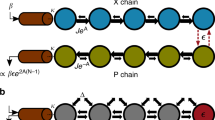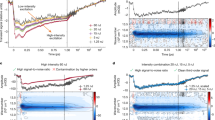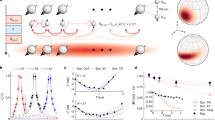Abstract
Laser-spectroscopic techniques that exploit light–matter entanglement promise access to many-body configurations. Their practical implementation, however, is hindered by the large number of coupled states involved. Here, we introduce a scheme to deal with this complexity by combining quantitative experiments with theoretical analysis. We analyse the absorption properties of semiconductor quantum wells and present a converging cluster-expansion transformation that robustly projects a large set of quantitative classical measurements onto the true quantum responses. Classical and quantum sources are shown to yield significantly different results; Schrödinger-cat states can enhance the signal by an order of magnitude. Moreover, squeezing of the source can help to individually control and characterize excitons, biexcitons and electron–hole complexes.
This is a preview of subscription content, access via your institution
Access options
Subscribe to this journal
Receive 12 print issues and online access
$209.00 per year
only $17.42 per issue
Buy this article
- Purchase on Springer Link
- Instant access to full article PDF
Prices may be subject to local taxes which are calculated during checkout





Similar content being viewed by others
References
Steinmeyer, G., Sutter, D. H., Gallmann, L., Matuschek, N. & Keller, U. Frontiers in ultrashort pulse generation: Pushing the limits in linear and nonlinear optics. Science 286, 1507–1512 (1999).
Zewail, A. H. Laser femtochemistry. Science 242, 1645–1653 (1988).
Hentschel, M. et al. Attosecond metrology. Nature 414, 509–513 (2001).
Jones, D. J. et al. Carrier-envelope phase control of femtosecond mode-locked lasers and direct optical frequency synthesis. Science 288, 635–639 (2000).
Escher, B. M., de Matos Filho, R. L. & Davidovich, L. General framework for estimating the ultimate precision limit in noisy quantum-enhanced metrology. Nature Phys. 7, 406–411 (2011).
Kira, M. & Koch, S. W. Quantum-optical spectroscopy of semiconductors. Phys. Rev. A 73, 013813 (2006).
Koch, S. W., Kira, M., Khitrova, G. & Gibbs, H. M. Excitons in new light. Nature Mater. 5, 523–531 (2006).
Eberly, J. H., Narozhny, N. B. & Sanchez-Mondragon, J. J. Periodic spontaneous collapse and revival in a simple quantum model. Phys. Rev. Lett. 44, 1323–1326 (1980).
Rempe, G., Klein, N. & Walther, H. Oberservation of quantum collapse and revival in a one-atom maser. Phys. Rev. Lett. 58, 353–356 (1987).
Brune, M. et al. Quantum Rabi oscillation: A direct test of field quantization in a cavity. Phys. Rev. Lett. 76, 1800–1803 (1996).
Kimble, H. J., Dagenais, M. & Mandel, L. Photon anti-bunching in resonance fluorescence. Phys. Rev. Lett. 39, 691–695 (1977).
Michler, P. et al. A quantum dot single-photon turnstile device. Science 290, 2282–2285 (2000).
Bouwmeester, D. et al. Experimental quantum teleportation. Nature 390, 575–579 (1997).
Furusawa, A. et al. Unconditional quantum teleportation. Science 282, 706–709 (1998).
Gisin, N., Ribordy, G., Tittel, W. & Zbinden, H. Quantum cryptography. Rev. Mod. Phys. 74, 145–195 (2002).
Monroe, C., Meekhof, D. M., King, B. E., Itano, W. M. & Wineland, D. J. Demonstration of a fundamental quantum logic gate. Phys. Rev. Lett. 75, 4714–4717 (1995).
Wigner, E. P. On the quantum correction for thermodynamic equilibrium. Phys. Rev. 40, 749–759 (1932).
Glauber, R. J. Coherent and incoherent states of the radiation field. Phys. Rev. 131, 2766–2788 (1963).
Sudarshan, E. C. G. Equivalence of semiclassical and quantum mechanical descriptions of statistical light beams. Phys. Rev. Lett. 10, 277–279 (1963).
Walls, D. F. & Milburn, G. J. Quantum Optics 2nd edn (Springer, 2008).
Schleich, W. & Wheeler, J. A. Oscillations in photon distribution of squeezed states and interference in phase space. Nature 326, 574–577 (1987).
Slusher, R. E., Yurke, B., Mertz, J. C., Valley, J. F. & Hollberg, L. W. Observation of squeezed states generated by four-wave mixing in an optical cavity. Phys. Rev. Lett. 55, 2409–2412 (1985).
Schwabl, F. Statistical Mechanics 2nd edn (Springer, 2006).
Kira, M. & Koch, S. W. Cluster-expansion representation in quantum optics. Phys. Rev. A 78, 022102 (2008).
Jaynes, E. T. & Cummings, F. W. Comparison of quantum and semiclassical radiation theories with application to beam maser. Proc. IEEE 51, 89–109 (1963).
Haug, H. & Koch, S. W. Quantum Theory of the Optical and Electronic Properties of Semiconductors 5th edn (World Scientific, 2009).
Kira, M. & Koch, S. W. Many-body correlations and excitonic effects in semiconductor spectroscopy. Prog. Quantum Electron. 30, 155–296 (2006).
Smith, R. P. et al. Extraction of many-body configurations from nonlinear absorption in semiconductor quantum wells. Phys. Rev. Lett. 104, 247401 (2010).
Usui, T. Excitations in a high density electron gas. Prog. Theor. Phys. 23, 787–798 (1960).
Turner, D. B. & Nelson, K. A. Coherent measurements of high-order electronic correlations in quantum wells. Nature 466, 1089–1092 (2010).
Acknowledgements
We thank R. P. Mirin, NIST-Boulder, for providing the epitaxially grown GaAs sample. The Marburg part is supported by the Deutsche Forschungsgemeinschaft and the work at JILA was supported by the NSF and NIST. S.T.C. acknowledges support from the Alexander von Humboldt Foundation.
Author information
Authors and Affiliations
Contributions
All authors contributed substantially to this work. The Marburg group is predominantly responsible for the development of the theory whereas the experiments have been performed by the JILA group.
Corresponding author
Ethics declarations
Competing interests
The authors declare no competing financial interests.
Supplementary information
Supplementary Information
Supplementary Information (PDF 1652 kb)
Rights and permissions
About this article
Cite this article
Kira, M., Koch, S., Smith, R. et al. Quantum spectroscopy with Schrödinger-cat states. Nature Phys 7, 799–804 (2011). https://doi.org/10.1038/nphys2091
Received:
Accepted:
Published:
Issue Date:
DOI: https://doi.org/10.1038/nphys2091
This article is cited by
-
Dynamical entropic measure of nonclassicality of phase-dependent family of Schrödinger cat states
Scientific Reports (2023)
-
Photon-statistics force in ultrafast electron dynamics
Nature Photonics (2023)
-
Lightwave electronics in condensed matter
Nature Reviews Materials (2023)
-
Separating single- from multi-particle dynamics in nonlinear spectroscopy
Nature (2023)
-
Nonreciprocal generation of Schrödinger cat state induced by topology
Science China Physics, Mechanics & Astronomy (2023)



